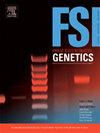Nanopore sequencing and haplotyping of mitochondrial DNA hypervariable regions and its application on mixed stain
IF 3.1
2区 医学
Q2 GENETICS & HEREDITY
引用次数: 0
Abstract
Objective
To explore the feasibility of mitochondrial DNA (mtDNA) haplotype detection by nanopore sequencing and its potential value in the identification of mixed biological samples in forensic DNA analysis.
Methods
Firstly, validation of the method for long fragments detection of human mtDNA hypervariable regions (HVRs) was carried out on the G-seq500 nanopore sequencing platform. Then, the amplified products of two DNA standards were mixed at different ratios to be sequenced and analyzed. Finally, the method established in this study was used to separate haplotypes of the mixed biological samples from simulated and real crime scenes.
Results
The nanopore sequencing protocol of mtDNA HVRs established in this study demonstrated human-specificity, accuracy comparable to Sanger sequencing and Next Generation Sequencing (NGS), high sensitivity, repeatability and broad applicability. Using Sanger sequencing results as the standard, the accuracy of DNA standards sequencing was 100 %. The sequencing results for random individual blood cards were consistent with that of NGS. The detection limit of DNA template could be as low as 0.0625 ng. The method was also applicable to various sample types, including blood, oral swab, hair with follicles, different tissues and exfoliated cells, and can effectively interpret the Poly-C region. The mixtures of amplified products at ratios of 1:1, 1:9, 1:19, 1:49 and 1:99 from two DNA standards, as well as amplified products of mixed blood samples from two unrelated individuals at ratios of 3:2, 17:3, and 24:1, were accurately sequenced and haplotype-separated using the G-seq500 nanopore sequencing platform. Using this technical scheme to detect the mixture of exfoliated cells in a rape case can accurately separate the haplotypes to identify the suspect.
Conclusion
The long-read nanopore sequencing of human mtDNA HVRs based on the G-seq500 platform meets forensic DNA methodological requirements and is operationally feasible. It holds great potential and application value in the identification of mixed biological samples in forensic DNA analysis.
线粒体DNA高变区纳米孔测序、单倍型及其在混合染色上的应用。
目的:探讨纳米孔测序检测线粒体DNA (mtDNA)单倍型的可行性及其在法医DNA分析中混合生物样品鉴定中的潜在价值。方法:首先,在G-seq500纳米孔测序平台上对人类mtDNA高变区(HVRs)长片段检测方法进行验证。然后,将两种DNA标准品的扩增产物按不同比例混合,进行测序和分析。最后,利用本研究建立的方法对模拟和真实犯罪现场的混合生物样本进行单倍型分离。结果:本研究建立的mtDNA HVRs纳米孔测序方案具有人类特异性,准确性可与Sanger测序和Next Generation sequencing (NGS)相媲美,灵敏度高,重复性好,适用性广。以Sanger测序结果为标准,DNA标准品测序准确率为100% %。随机个体血卡测序结果与NGS一致。DNA模板的检出限低至0.0625 ng。该方法也适用于血液、口腔拭子、有毛囊的头发、不同组织和脱落细胞等多种样品类型,并能有效地解释Poly-C区域。使用G-seq500纳米孔测序平台对两种DNA标准品1:1、1:9、1:19、1:49和1:99比例的扩增产物,以及两种非亲缘关系个体混合血液样本3:2、17:3和24:1比例的扩增产物进行准确测序和单倍型分离。利用该技术方案检测强奸案中脱落细胞的混合物,可以准确地分离单倍型,从而识别嫌疑人。结论:基于G-seq500平台的人mtDNA HVRs长读纳米孔测序满足法医DNA方法学要求,操作可行。它在法医DNA分析中混合生物样品的鉴定中具有很大的潜力和应用价值。
本文章由计算机程序翻译,如有差异,请以英文原文为准。
求助全文
约1分钟内获得全文
求助全文
来源期刊
CiteScore
7.50
自引率
32.30%
发文量
132
审稿时长
11.3 weeks
期刊介绍:
Forensic Science International: Genetics is the premier journal in the field of Forensic Genetics. This branch of Forensic Science can be defined as the application of genetics to human and non-human material (in the sense of a science with the purpose of studying inherited characteristics for the analysis of inter- and intra-specific variations in populations) for the resolution of legal conflicts.
The scope of the journal includes:
Forensic applications of human polymorphism.
Testing of paternity and other family relationships, immigration cases, typing of biological stains and tissues from criminal casework, identification of human remains by DNA testing methodologies.
Description of human polymorphisms of forensic interest, with special interest in DNA polymorphisms.
Autosomal DNA polymorphisms, mini- and microsatellites (or short tandem repeats, STRs), single nucleotide polymorphisms (SNPs), X and Y chromosome polymorphisms, mtDNA polymorphisms, and any other type of DNA variation with potential forensic applications.
Non-human DNA polymorphisms for crime scene investigation.
Population genetics of human polymorphisms of forensic interest.
Population data, especially from DNA polymorphisms of interest for the solution of forensic problems.
DNA typing methodologies and strategies.
Biostatistical methods in forensic genetics.
Evaluation of DNA evidence in forensic problems (such as paternity or immigration cases, criminal casework, identification), classical and new statistical approaches.
Standards in forensic genetics.
Recommendations of regulatory bodies concerning methods, markers, interpretation or strategies or proposals for procedural or technical standards.
Quality control.
Quality control and quality assurance strategies, proficiency testing for DNA typing methodologies.
Criminal DNA databases.
Technical, legal and statistical issues.
General ethical and legal issues related to forensic genetics.

 求助内容:
求助内容: 应助结果提醒方式:
应助结果提醒方式:


